
MAHSR Package T3
Building India’s first precast track slab system
for High-Speed Railways
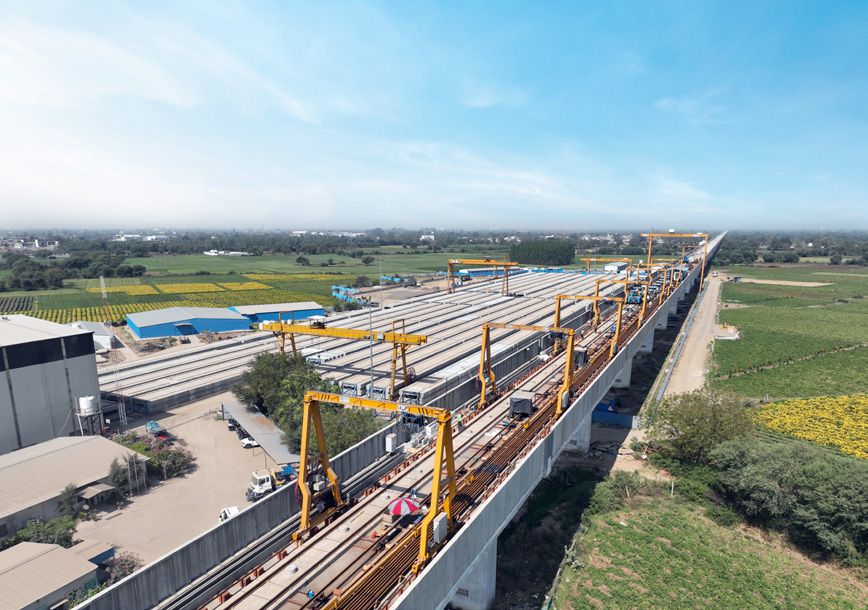
Seven Telphers standing tall, working in tandem to handle 200 m rail panels on the ‘Yard on Viaduct’
Custom engineering Japan’s high-speed rail technology – the Shinkansen system – to Indian conditions has been the sternest challenge for Project Manager, Rajkumar Pardhi and his team at the Mumbai-Ahmedabad High Speed Rail (MAHSR) project, Package T3.
“The Japanese systems are built on decades of precision engineering and operational excellence but adapting and tailoring them to India’s unique geographical, climatic, and logistical conditions required a lot of custom engineering,” observes Project Director, A S Phanendra Kumar. “Custom engineering was not just about localizing the technology but having to scale it efficiently across vast terrains, maintaining the stringent standards required for high-speed operations.
The project scope encompasses track works for 116 route km (RKM), equal to 230 track km (TKM) of main lines including viaducts, stations and turnouts with 25 TKM for the Sabarmati Depot.
Introducing India’s first Shinkansen J-Slab Track System
A high-speed rail system involving trains zipping around at speeds of 320 kmph requires extremely accurate slab tracks that are directly linked to the quality of the supporting structures. The design of the J-Slab ballast-less track system features JIS 60 kg rails, track slabs, cement asphalt mortar, RC track bed & anchors, and rail fasteners that ensure precision, superior ride quality, enhanced durability, and low maintenance.
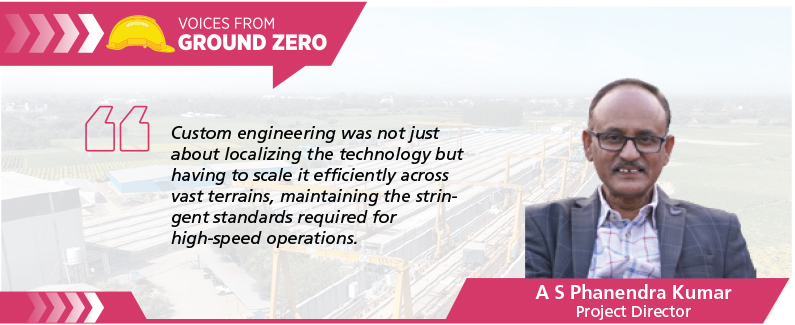
Elaborating on the J-Slab track system that will set a new benchmark for rail infrastructure in India, overseen by the National High Speed Rail Corporation Limited (NHSRCL) with consultancy from Japan International Consultants Consortium (JICC), Rajkumar says, “Its large-scale indigenization marks a landmark for India’s rail industry and the design’s inherent safety features, including its ballast-less structure and precise alignment with tolerances as tight as ±1 mm, allow the track to meet all high-speed rail safety regulations without the need for derailment guards.” This contrasts with other Indian rail projects, such as the Regional Rapid Transit Systems (RRTS) or metro systems, in which derailment guards are necessary due to different track designs and operational speeds.
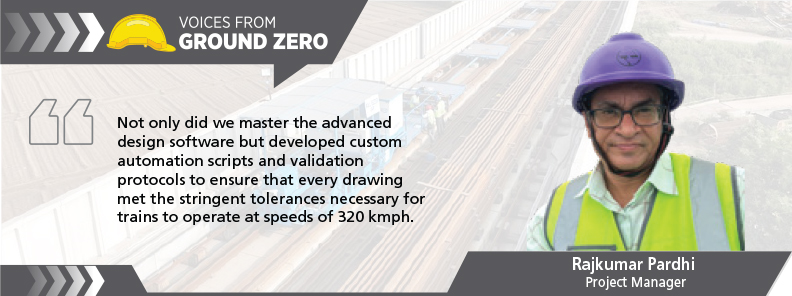
Breaking new ground in design & construction
The T3 project’s design automation process utilizes inputs from survey data collected via tools like total stations, alignment design data, generated drawings including critical details like RC anchor coordinates, track slab types, civil structural information (e.g., pier locations), alignment specifics (e.g., rail levels), & construction requirements (e.g., RC track bed dimensions) and Excel files.
“To manage the complexity of track construction, we have automated 7,000+ construction drawings by integrating Dynamo with Civil 3D and Revit, a customized computational design module, and a 3D digital twin, to automate annotations, draw production, and extract bill of quantities (BOQ),” explains Planning Manager, Ravi Mishra.
Aligning with Japanese standards demanded four-digit precision in all design outputs, alien to Indian railway projects. “With no prior experience of such accuracy levels, we still successfully adopted and implemented the required technology and workflows,” says Rajkumar, with a triumphant air. “Not only did we master the advanced design software but developed custom automation scripts and validation protocols to ensure that every drawing met the stringent tolerances necessary for trains to operate at speeds of 320 kmph.”
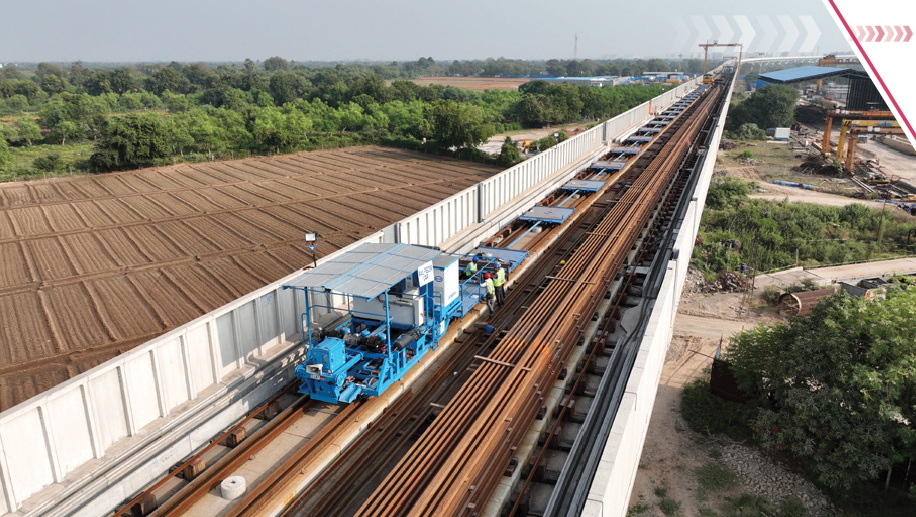
In a step towards indigenization, L&T‘s in-housemanufactured
Rail Feeder Car replaces the Japanese-made car on the MAHSR T3 viaduct
Reimagining productivity
While Japanese high-speed rail construction relies on proven but often labour-intensive methods, such as the use of large mobile cranes for handling and installation, Phanendra Kumar points out that their call to eliminate multiple mobile cranes and instead use only a single Goliath crane has streamlined the process, reduced complexities, improved productivity and boosted efficiency at the Track Construction Base (TCB).
Another example of technology adoption has been the development of specialized P&M, tailored for high-speed rail construction. “These reflect a blend of Japanese precision with Indian ingenuity,” smiles Rajkumar, “with many of these faster and more efficient than some of the traditional Shinkansen methods.” The cherry on the cake is that all the specialised P&M have been indigenously manufactured by L&T Construction Equipment Limited.
- Track Slab Laying Car: that lays 5 slabs at a time at 200 TM per shift using automated alignment systems
- Rail Feeder Cars: that delivers 200 m rail panels at 1 TKM per day with precision-guided mechanisms
- CA Mortar Injection Cars: that mix and inject Cement Asphalt Mortar (CAM) between the RC track beds and slabs at 200 TM per shift, leveraging real-time monitoring technology

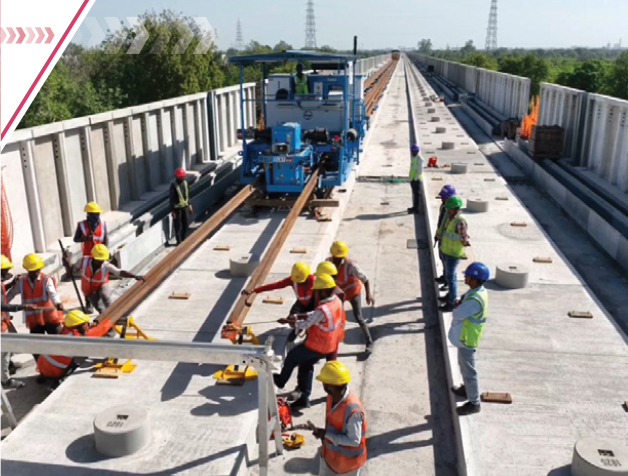
Standard-gauge temporary track being laid on RC track bed
A 1 km-long rail welding assembly line for converting 25 m rail into 200 m rail panels reduces defects & increases productivity, while mechanised rollers ease the movement of rails. Welds undergo additional tests like MPI (Magnetic Particle Inspection) to ensure zero exterior flaws and 5S is implemented at all stages.
The linear track slab factory line that optimizes the casting process, ensuring quality and speed, features:
- 100% rebar coils cut automatically for zero wastage
- Customized jigs for rebar cage production
- Battery-operated trolleys for cage transport
- Quality checked & tested inserts for 50 KN pullout strength and electrical resistance
- 48 domestic moulds with 1 mm tolerance
- Steam curing that accelerates production while maintaining quality
Explaining the slab casting process, Project Control Head, Ponmanikumaran, says that automated controlled valves are deployed during steam curing to optimize fuel consumption.
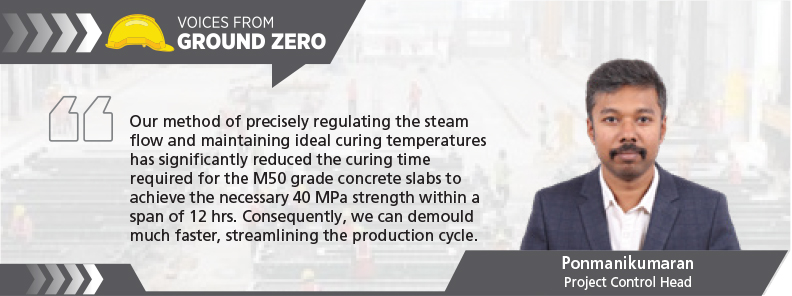
“Our method of precisely regulating the steam flow and maintaining ideal curing temperatures has significantly reduced the curing time required for the M50 grade concrete slabs to achieve the necessary 40 MPa strength within a span of 12 hrs. Consequently, we can demould much faster, streamlining the production cycle.”
As part of the team’s continued commitment to sustainable construction practices, they have adopted a biodiesel-fuelled boiler for steam curing at the Track Slab Manufacturing Facility that has significantly reduced carbon footprint by replacing conventional fossil fuels with biodiesel. For Phanendra and team, this is a significant contribution to the company’s vision of carbon neutrality, setting a precedence for greener infrastructure development.
Other comprehensive improvements across the entire production process leveraging indigenous technologies and process optimizations beyond just curing, have collectively doubled the daily output to 60 slabs, compared to the typical Japanese production rate of 30 slabs per day, showcasing the effectiveness of in-house innovations in scaling up operations. “Over 250 of our professionals have been trained on Shinkansen technology and certified by Japanese experts,” Ponmanikumaran mentions, “and this knowledge transfer empowers us to uphold global standards in high-speed rail construction,” he says rousingly.
Proving that quality and safety go hand in hand, the team’s EHS performance has been recognized with the Gold Award in Green Enviro Environment Award (2025), RoSPA Gold Award, International Safety Award, and the Pollution Control Waste Management & Recycling Award (2024); in July 2025, the project was awarded the Five Star Rating in the British Safety Council’s Five Star Audit in recognition of its outstanding Health, Safety, and Environment (HSE) practices.. It is evidently clear that the task before Phanendra Kumar, Rajkumar, and their team is to keep a good thing on tracks, with speed.
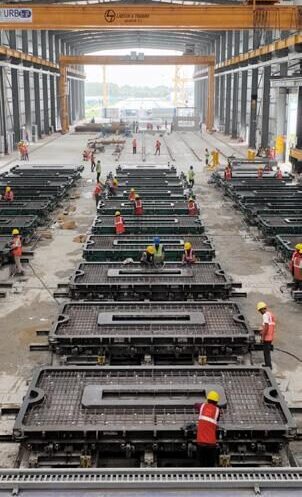
Daily casting underway at TSMF, Anand, targeting a peak output of 63 slabs each day
RRTS Delhi–Ghaziabad–Meerut Project
Building India’s first precast track slab system for high-speed urban transit
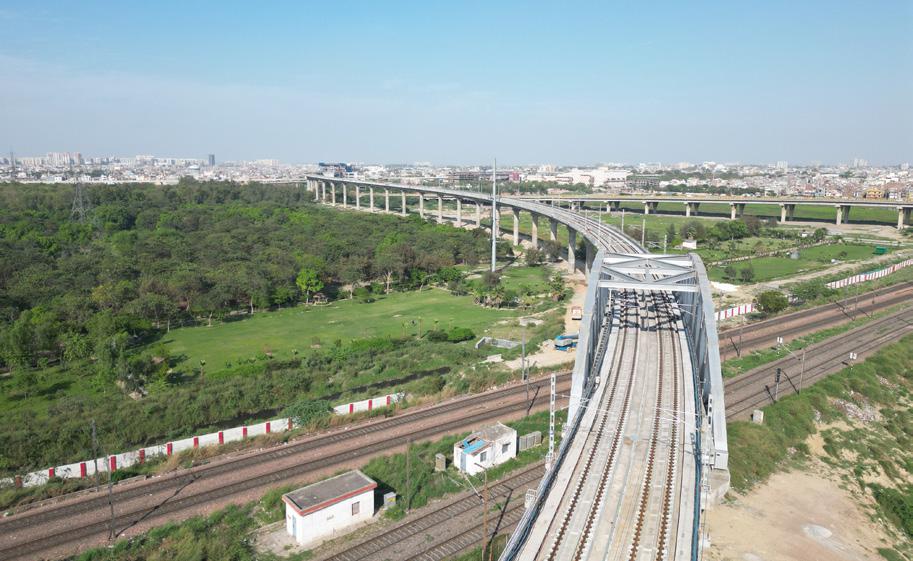
India’s first rapid rail corridor linking Delhi and NCR regions through cutting-edge technology
Custom engineering transferred technology is the recurring theme at the RRTS (Regional Rapid Transit System) DelhiGhaziabad-Meerut project too, where a TI IC RBG team, led by Project Director, Shyam Baboo Saraswat, is developing and deploying tech solutions for sub-system management, slab traceability and supply chain management to build India’s first precast track slab system for high-speed urban transit. The team is executing ballast-less slab track works including manufacturing, supplying, and installing for the entire stretch of 81 RKM/212 TKM (145 TKM on viaduct, 24 TKM underground & 43 TKM of depot tracks).
The FARO System has wiped out defects
Acutely aware of their responsibility to maintain zero defects when precasting the track slabs to build high-quality semi-high-speed transit systems with precise alignment, the team has adopted the FARO 3D Laser Scanning System that has emerged as a game-changer, assuring quality and dimensional accuracy. It is a 3D laser scanning and measurement tool that captures the entire geometry of an object or surface in real-time. “FARO ensures precise dimensions in precast track slab production, minimizes rework and rejection rates and achieves consistency and reliability in alignment for high-speed train operations,” states an impressed Shyam. Through a Technology Transfer from systems provider, PORR (Austria), FARO has increased speed, improved both service life and maintainability.
The FARO system inspects (non-contact dimensional) the precast slabs that measure over 4 m x 2.4 m and weighing over 4 tons, generates as-built 3D models to compare against design specifications and can detect minute surface undulations, alignment issues, and profile deviations. “The FARO system has gone a long way to help us achieve our ‘Zero Defect, Zero Effect’ vision,” shares Project Control & Planning Manager Nikhil Goyal, ticking off its various advantages. “100% inspection accuracy for critical dimensions (length, width, thickness, embed locations, curvature), reduction in slab rejection rate to near-zero, enhanced traceability and documentation through digital inspection records, time and cost savings due to minimized manual errors and rework and improved interface with installation teams through precise slab data.”
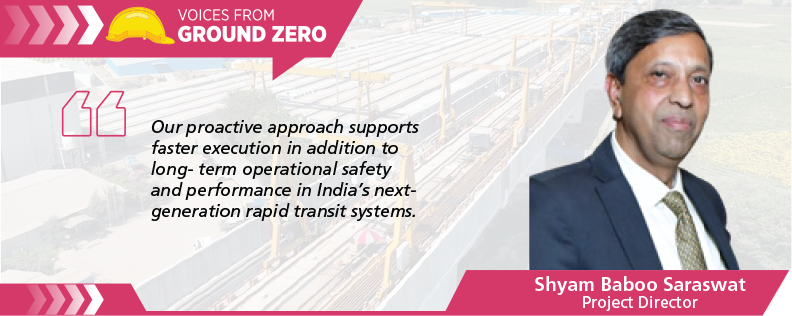
As part of their implementation strategy, the team has integrated FARO inspection at the mould setup and postcasting stages, are training QA/QC teams for on-site FARO usage and data interpretation, automating deviation analysis with pre-set tolerances in design software and establishing a feedback loop to production for continuous improvement. “Our proactive approach supports faster execution in addition to long-term operational safety and performance in India’s next-generation rapid transit systems,” says Shyam, with a winning smile.
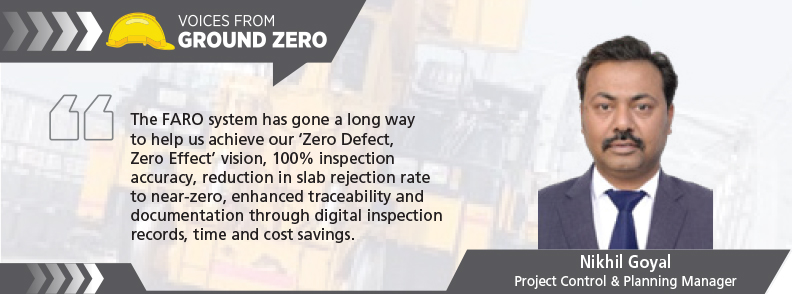
135 slab track turnouts for better ride quality
Although demanding precision and expertise due to their rigid concrete base integration, the team opted for slab track turnouts in favour of conventional ballasted track systems for smoother & more reliable movement across main lines, sidings, and crossovers.
These also promise long service life, reduced vibrations, and consistent geometry. “We installed 135 slab track turnouts across the corridor, 119 on viaduct sections and the other 16 on underground segments,” informs Nikhil, “and each turnout installation was an intricate process, utilizing a combination of specialized materials and equipment.”Founded on precast turnout slabs, complemented by switch and stock rails along with fastening systems, the turnouts have been installed using sophisticated tools like hydraulic jacks, rail changers, precision survey instruments, RRV Hydra 360 for slab handling and more.
Despite facing difficulties in transporting and stacking heavy slabs weighing up to 5.5 MT, especially within congested urban zones, restricted operating spaces, logistical hurdles and a workforce executing this kind of work for the first time, the team pulled off all the 135 installations flawlessly. “Close supervision, hands-on training, and constant technical support are the prime reasons of our success,” smiles Shyam, agreeing that maintaining minimum tolerances for slab alignment without causing structural damage was no laughing matter. These slab track turnouts will now serve as a backbone for efficient train movement, boosting the RRTS Metro’s operational flexibility and long-term reliability.
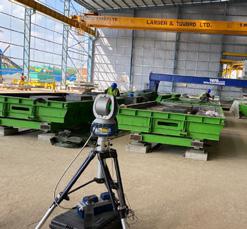
Installing slabs with a self-propelled rail-cum-road crane
Forewarned is to be forearmed. Despite executing such a project for the first time in India, the team anticipated the challenges of safely and efficiently handling the precast slabs and the non-availability of special P&M in the country. Apart from having to lift more than 300 slabs in the station areas, they were constrained by the lack of space to position cranes to install the 170 turnout slabs that called for a methodology involving 24-hours shifts and machinery to handle slabs weighing some 5.5 tons. Replacement of slabs both on the viaduct and inside the tunnel was difficult and time-consuming that was putting the team under additional pressure from other interfacing contractors for access.
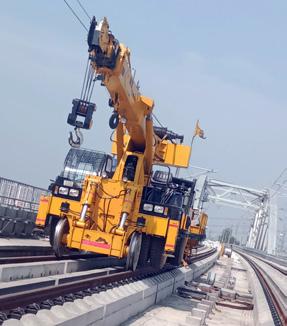
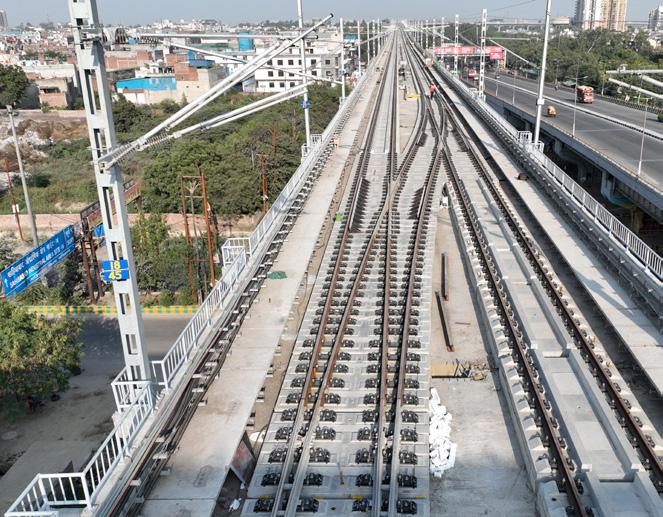
Silent strength beneath the rails: slab track turnouts weaving seamless paths through tunnels and viaducts, shaping RRTS’s future
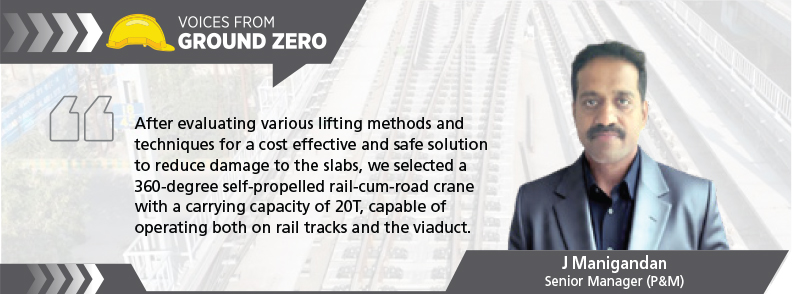
Initially, the team had deployed regular road-based cranes with capacities of over 120T/250T for shifting and installing the slabs but the issue for Senior Manager (P&M), J Manigandan was that these could only be operated at night in limited traffic blocks. It also did not address his other challenge of constrained working space.
“After evaluating various lifting methods and techniques for a cost effective and safe solution to reduce damage to the slabs, we selected a 360-degree self-propelled rail-cum-road crane with a carrying capacity of 20T, capable of operating both on rail tracks and the viaduct,” he informs with a sense of achievement. Equipped with two powered bogies, the crane has a hydrostatic drive on rail and when operating on rails, the rubber tires are raised, and can travel at speeds of up to 20 km/h. Apart from emergency stop buttons, a pneumatic fail-safe service and parking brake system are in place, with an auxiliary pneumatic circuit for easy switching between rail and road braking modes while sensors can mechanically lock the crane to ensure safety. Dual mechanical locks on each bogie ensure safe movement and in case of engine or hydraulic failure, a manual towing mode can be engaged, with towing speeds of up to 10 km/h. Speeds are restricted by a PLC.
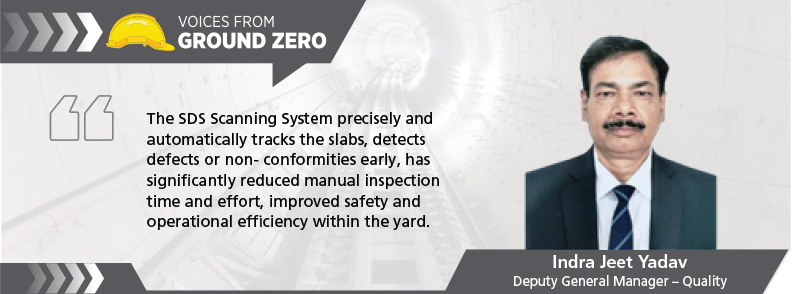
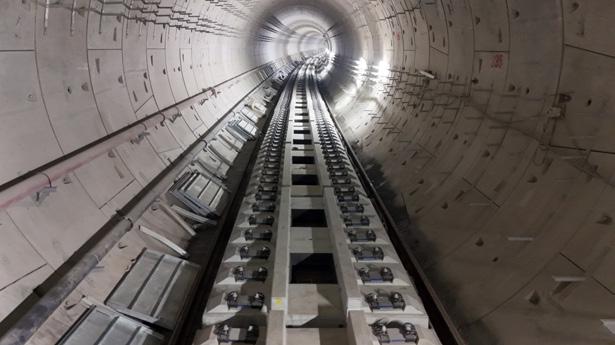
RRTS tunnel track works demand state-of-the-art machinery, expert craftsmanship, noise
mitigation strategies, and rigorous compliance with engineering standards and project schedules
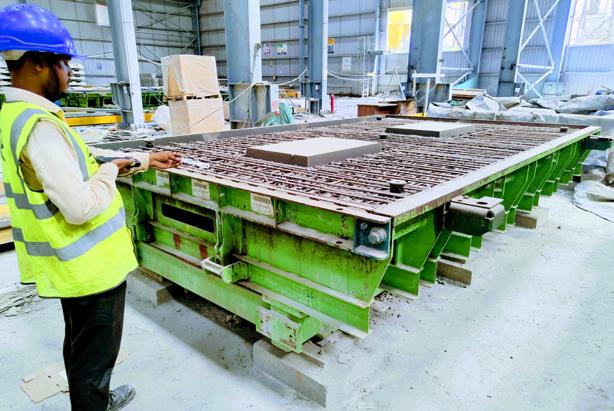
Advanced technology used to produce high-strength ballastless
track slabs with longer life spans, requiring less maintenance
SDS scanning system in the track slab yard
Equipped with scanning devices, identification tags, data processing systems and user interfaces, the SDS Scanning System can accurately identify each slab and monitor its location within the yard, inspect slabs for defects or deviations from specified standards and enhance inventory control & streamline quality assurance processes.
The workflow involves tagging the slabs with barcodes during manufacturing or upon arrival at the yard, scanning the dimensions of each slab & its surface quality, comparing them with the design parameters to detect any defects or deviations, tracking its location, logging orientations, providing inspection results in real time, triggering alerts of any defective slabs and generating detailed reports for quality control & inventory management.
Indra Jeet Yadav, Deputy General Manager – Quality, is a happier man now. “The SDS Scanning System precisely and automatically tracks the slabs, detects defects or non-conformities early, has significantly reduced manual inspection time and effort, improved safety and operational efficiency within the yard,” he says, with josh.
RRV pump simplifies concrete transportation & casting in tunnels
With installations in tunnel sections required at two separate locations in Delhi & Meerut, of approximately 24 TKM, the team has installed a RRV Pump to easily transport and cast concrete. Fitted on wheels, it can be towed into position and its hydraulic power pack prevents the pump from being in direct contact with the track or else its vibrations during operation could have disrupted the carefully calibrated track parameters. With modifications carried out on site at the workshop, the pump is working perfectly inside the tunnels.
Shyam and his hardy set of engineers & workers have a task on their hands to deliver India’s first precast slab system for high-speed urban transit, and they are doing it in style by constantly thinking off the beaten tracks, adroitly customizing technology to suit local conditions. Here’s to their continued success.